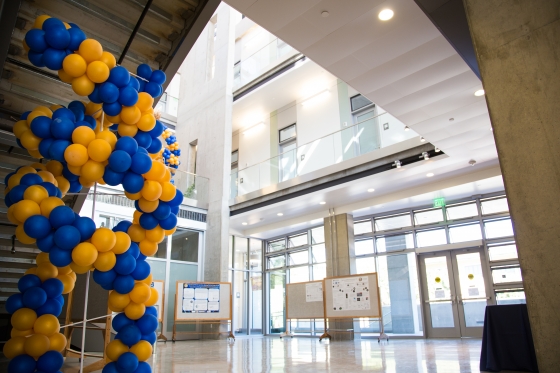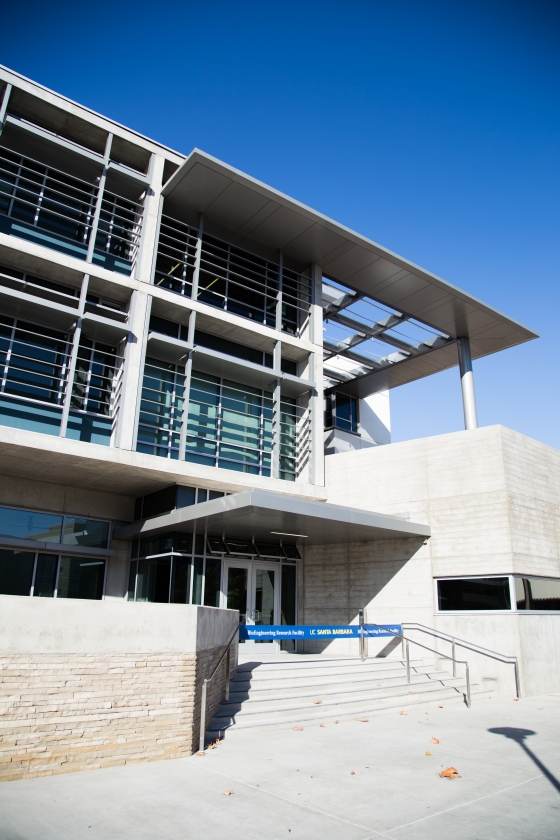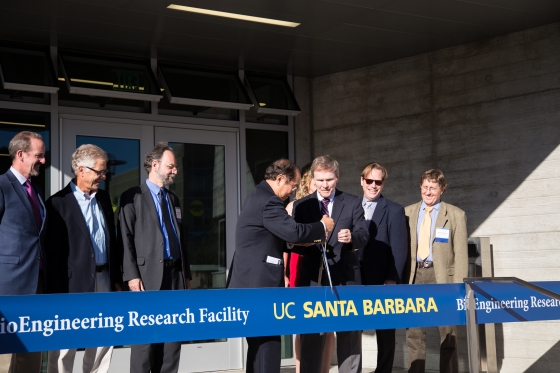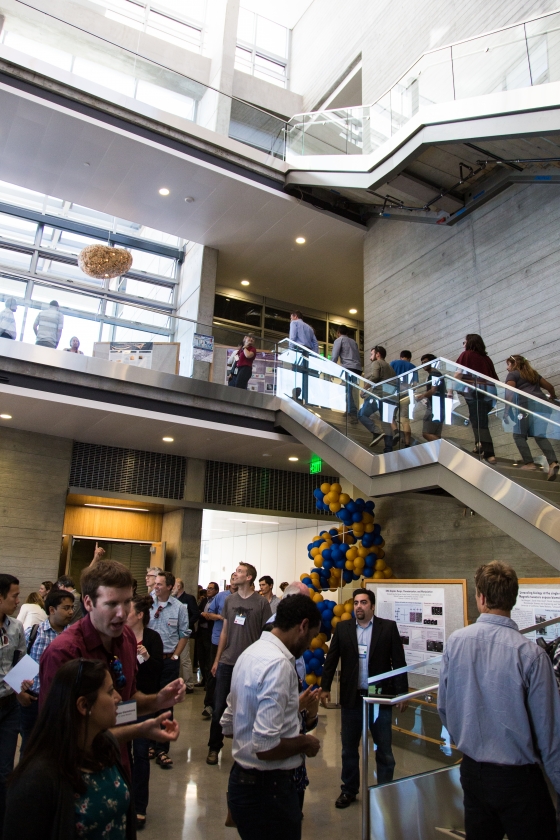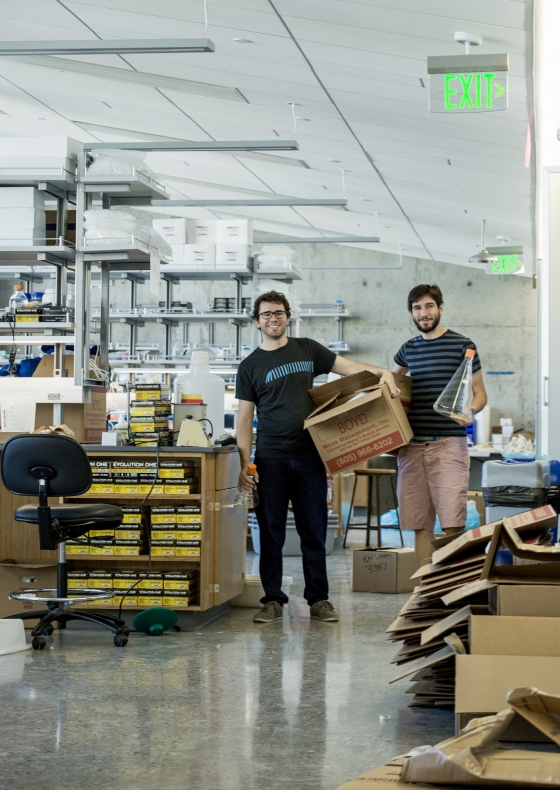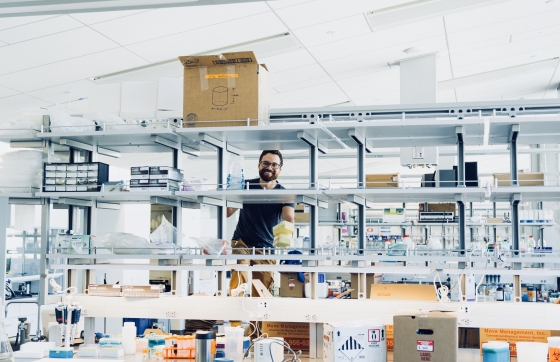After a decade of planning, a complex fundraising effort that included the obstacle of the Great Recession, and nearly three years of construction, the new $86 million BioEngineering Building at UC Santa Barbara had its grand opening on October 19, with Chancellor Henry Yang and College of Engineering Dean Rod Alferness cutting the ceremonial ribbon as faculty, staff, donors, members of the Dean’s Cabinet, and others in the UCSB community cheered.
“This is the culmination of years of visionary work and the beginning of a new era of research collaboration on our campus,” said the chancellor. He added that whenever he gives an orientation talk to prospective engineering students, they always ask when the College of Engineering will offer a degree in bioengineering. “With the opening of this building, that reality becomes closer,” he said.
The building will be home to 15 faculty who, Alferness said, “will mentor and guide some 165 graduate students and postdoctoral researchers on a journey of problem-solving and discovery in a shared 21st-century laboratory space, where new collaborations and cross-discipline directions will be forged as we continue to build on what is already a highly research-productive and impactful bioengineering community on this campus.”
Alferness also mentioned UCSB’s intention to create a formal bioengineering department.
“Bioengineering is an exciting field in terms of both its enormous potential for new discovery, but also, and especially, I would argue, in the hands of engineers, to leverage that new knowledge to heal people and improve their lives.”
The 45,000-square-foot glass, metal and concrete building, designed by the architectural firm Moore Ruble Yudell, includes 17,200 square feet of laboratory space and a range of cutting-edge “smart” sustainability features. The building takes advantage of natural light and ventilation on the south side, where offices are located, while the large, shared lab spaces have been located on the north side, making important temperature control easy and efficient.
Inside, several lamps by artist Aaron Kramer, made of coffee stirrers and thin strips of recycled hardwood woven to resemble the biomorphic shapes of red blood cells, hang in the soaring three-story atrium space, which pulls together the three separate levels of the building into one single, shared space. Three digital paintings by CoE Marketing Director Peter Allen and multimedia designer Brian Long hang at the end of the long hallway on each floor, adding science-centric interior accents.
“Buildings like this are crucial in that they allow people to come together from many different departments in order to talk and learn from each other, which provides a source of ideas and creativity and applications that wouldn’t happen otherwise if people are in their respective silos of isolation,” said Brad Chmelka, Co-Director of UCSB's Institute for Collaborative Biotechnologies. “The future is brighter for a broad range of shared research because of this investment.”
“This is a gorgeous building that we are so pleased and proud to call our new home, but I’m also excited at a higher level by what the building means to bioengineering at UCSB,” said Kevin Plaxco, Director of the UCSB Center for BioEngineering. “At many schools, bioengineering really means biomedical engineering, so building devices to solve today’s medical problems. That’s an amazing and venerated field, and we do some biomedical engineering here, of course, but we’re also looking farther. We want to do revolutionary things to solve challenges ten years from now, or thirty years from now. We’re trying to steal from nature the tricks — the materials and the ideas — that evolution has invented to solve problems and apply those to a broad range of human problems.
“These are things that require us to bring together faculty from different disciplines with backgrounds and different languages and meld from them a single community. And there’s no playbook to do that. We have to write our own. When we sat down to plan this building, we challenged the architects to design a building that would d play an integral role in bringing us together, a building that wouldn’t be a bunch of separate floors where no one sees one another, but a building that feels like a whole organic edifice. A building that forces people to encounter each other in the hall, and when they do, there are appealing places to sit down and talk about scientific problems. I’ve just moved in, but I’m pretty confident they pulled it off.”
“Today we find ourselves at a very exciting dawn of engineering, science, and medicine based on bio-mimetic, bio-inspired, bio-enabled materials and processes,” said UCSB Executive Vice Chancellor David Marshall. “And as science learns from nature and learns how to imitate nature, we also discover how the principles and practices of engineering can give us new insights into the building blocks and fundamental processes of life, allowing us both to understand and reverse-engineer the principles and processes of biology.
“Situated at the intersection of science and nature, of biology and engineering, this new BioEngineering building also stands for the interdisciplinary and collaborative culture that has made UC Santa Barbara a great research university,” he continued. “At this precarious moment, when we are compelled to be less dependent on the state, this building also represents the entrepreneurial spirit of the campus and the insistence that we find ways to pursue the acts of discovery that illustrate how a great public university can contribute to society.

Chancellor Henry T. Yang, College of Engineering dean, Rod Alferness, and UCSB faculty members prepare to cut the ribbon at the official opening ceremony for the new BioEngineering building.

